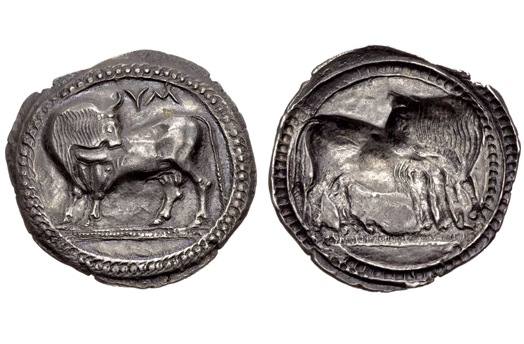
about ancient nomos
Ancient Nomos Art is a museum of galleries exhibiting ancient coins and ancient mint maps. The coin gallery displays the diverse art and history of hand-crafted ancient Greek, Roman, Byzantine, Persian and Medieval coinage. The ancient mints mapping gallery features Greek, Roman, Byzantine, Asia Minor and Medieval mint city regions and territories. Visitor's are welcome to explore, study and enjoy Ancient Nomos Art.

Greek, Sybaris – 550 BC
Sybaris Nomos
From Ancient Galleries

Obverse: Bull standing left with head fully turned to the right.
Reverse: Bull also standing right, but with head fully turned to the left.
LEGEND SYMBOLS
Obv: Bull standing left with head fully turned to the right; VM above. Rev: Incuse Bull also standing right, but with head fully turned to the left.
The ancient city of Sybaris is thought to have been discovered by Greek Achaeans and Troezenians colonies around 720 BC. The ancient city is located along the gulf coast of Taranto in the region of northeast of Calabria and is surrounded by the fertile Sibari planes. The city prospered for many reasons, but primarily because, as Diodorus Siculus (90-27 BC) noted, “the immigration policy of Sybarite authorities was to offer free citizenship” to any Greek settling in the region. The bountiful Sybariti prosperity perhaps justifying Diodorus Siculus’ later claim that the people of Sybaris soon became “slaves of their bellies and lovers of luxury”. Nevertheless, the agricultural prosperity of the Sybaris region grew rapidly, eventually leading to its political and economic leadership in the region. Neighboring communities took notice with a watchful eye and a likely tendency toward distain, especially the nearby city of Kroton. In fact the arrogance of Sibariti was well known throughout the ancient world – again according to Diodorus Siculus. The city grew rapidly to over 300,000 denizens by the year 530 BC. The above nomos coin dates to the earliest Magna-Grecia archaic period of Sybarite coinage. In fact, some numismatists believe the Sybaris nomos was the first coinage produced by the Greeks of Magna-Grecia. Above the cities mythic and symbolic Bull is the first two Greek letters engraved as a sigma and epsilon. The wonderful depiction of a mature Bull in repose is seen gently turning his head back as though he is leading the herd or watching over the vast Sybarite fields. The artful figure of the symbolic Bull is in extremely high relief strike for this series, with a cleverly contorted design that follows the round outlines of the engravers die, and also matching the circular flan form. Some believe the symbolic Bull may be a metaphor of the two rivers Krathis and Sybaris in the Taranto valley. The nomos reverse is an incuse version of the obverse Bull. The slight reverse doubling, particularly on the forepart of the bull, demonstrates the normal multiple strike format typical for all incuse Magna-Grecia issues. However, in this specimen the obverse die remained close to perfectly aligned resulting is a coin of very high relief. Many of Sicily’s Magna-Grecia cities issued similar incuse reverse coins with a corresponding weight standard shared by each of the regional cities to facilitate trade. For example, Metapontian coinage was symbolized by a barley grain (see Metapontion nomos), Kroton a tripod (see Kroton stater), the myth of Apollo by Kaulonia (see Kaulonia stater) and Selinos as symbolized by the celery leaf (see Selinos didrachm). Sybaris thrived for over two hundred year when, according to Diodor, Sybaris was razed to the ground by Kroton in 510 BC after the Sybarites banished 500 of the richest Troezenian citizens, confiscate their wealth and land. This lead to a great battle along the banks of the Traente River, where the Troezenian’s aligned with the Kroton’s to defeat the Sybariti, looting and then leveling the city where all was largely destroyed. Many believe the Sybarites “hubris” toward their wealthiest citizens was a justifiable punishment for the seizure of private property without a corresponding due process or cause. Apparently, after this historic event, the Kroton’s presumably altered the flow of the nearby Crati River and the city of Sybaris was then flooded beyond recognition.
DOCUMENTATION
Value: Nomos. Metal: AR Silver. Weight: 7.43 grams. Mint: Sybaris, Magna-Grecia. Date: circa 550-510 BC.
Attribution: S&S Class A, Plate XLVIII, 1–3; Gorini, 3; SNG ANS 817–27; Basel, 167; Dewing 405; Kraay and Hirmer 212; SNG München 1157; Historia Numorum Italy, 1729; NAC 82, 20; Sternberg 1988, 15 (this coin).
Legend, Documentation and Attribution
